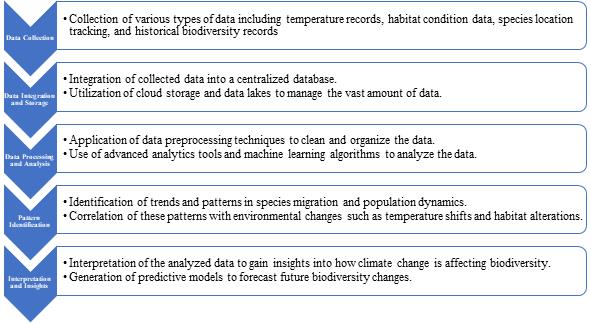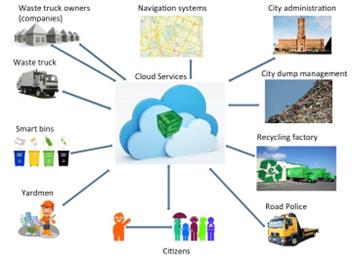1. Introduction
The nexus of big data and environmental science has emerged as a pivotal force in our global effort to combat climate change and pursue sustainable environmental management. This synergy, driven by the rapid advancements in data analytics and an exponential increase in data generation, is reshaping our understanding and approach towards environmental issues. This article delves into the transformative impact of big data across various environmental domains, including climate modeling, ecosystem monitoring, resource management, and policy formulation. The capability of big data to handle vast, diverse datasets has revolutionized predictive accuracy in climate science, offering more precise forecasts of weather patterns, temperature anomalies, and sea-level rise. Additionally, it has enabled a more nuanced understanding of ecosystem health, biodiversity dynamics, and the effects of anthropogenic activities on natural resources. In the realm of sustainable management, big data has been instrumental in optimizing resource use, enhancing waste management systems, and improving agricultural practices through precision farming techniques. Furthermore, it provides policymakers with robust, data-driven insights, facilitating informed and strategic decision-making [1]. As the planet faces escalating environmental challenges, the role of big data in environmental science becomes increasingly vital. This article aims to explore the multifaceted applications of big data in environmental management, illustrating its potential to foster a sustainable and resilient future. Through detailed discussions and specific case studies, we aim to highlight how big data analytics are not just tools for understanding but also instruments for action in the face of global environmental challenges.
2. Climate Change and Big Data
2.1. Modeling and Predictions
The advancement in big data technologies has significantly enhanced the capabilities of climate modeling. Modern climate models incorporate vast arrays of data, including historical weather patterns, oceanic currents, atmospheric compositions, and greenhouse gas emission trajectories. This integration allows for a more granular understanding of the climate system. For example, recent studies have utilized satellite data and ground-based observations to refine predictions of temperature anomalies, leading to more precise regional climate projections [2]. Advanced computational techniques, like machine learning algorithms, are now being employed to analyze these large datasets, resulting in more accurate and timely predictions of extreme weather events, such as hurricanes and droughts. The use of high-resolution data has also improved sea-level rise projections by incorporating factors like glacial melt rates and thermal expansion of oceans with greater accuracy.
2.2. Impact Assessment
The assessment of climate change impacts has been transformed by the ability to process and analyze large-scale environmental data. Comprehensive databases now include detailed records of climate variables, ecological indicators, and socio-economic data, allowing researchers to delineate the multifaceted impacts of climate change. For instance, big data analytics has been instrumental in identifying patterns in shifts of biodiversity, with studies demonstrating how species migration and population dynamics are responding to changing temperatures and habitat conditions. Figure 1 illustrates the process of using big data analytics to identify patterns in shifts of biodiversity due to climate change [3]. In terms of socio-economic impacts, data-driven approaches are being used to understand the repercussions of climate change on agricultural productivity, human health, and economic stability. By integrating climatic data with agricultural yield records and health databases, researchers have been able to correlate climate variability with food security issues and the prevalence of climate-sensitive diseases.

Figure 1. Utilizing Big Data Analytics to Understand Biodiversity Shifts in Response to Climate Change
2.3. Policy and Decision Making
The role of big data in informing climate policy and decision-making is becoming increasingly vital. Data analytics provides a robust foundation for evaluating the effectiveness of climate policies and strategies. For instance, carbon emissions data, when analyzed alongside policy implementations, can reveal the effectiveness of various carbon reduction strategies across different regions and industries. Predictive modeling, using large datasets, aids in forecasting the outcomes of policy decisions, thus allowing policymakers to make more informed choices. For example, energy consumption data, when combined with renewable energy production statistics, can help in designing policies for energy transition towards more sustainable sources [4]. Furthermore, big data is instrumental in scenario analysis, enabling policymakers to assess the potential impacts of different policy choices and climate actions, thereby helping to develop targeted and adaptive strategies for climate mitigation and adaptation.
3. Ecosystem Health Monitoring
3.1. Biodiversity Analysis
In the realm of biodiversity analysis, advanced data analytics methodologies are instrumental in comprehensively tracking and understanding changes within ecosystems. By leveraging large-scale datasets and employing techniques such as species distribution modeling, machine learning algorithms, and remote sensing, researchers can delve into the intricate dynamics of biodiversity [5]. These approaches facilitate the identification of species at risk, assessing the impacts of climate change on species distributions, and monitoring the consequences of habitat loss and fragmentation on local flora and fauna. Moreover, genetic sequencing technologies and DNA barcoding further enhance our ability to catalog and classify species, contributing to a more detailed and precise understanding of biodiversity changes [6].
3.2. Ecosystem Services Evaluation
The evaluation of ecosystem services benefits greatly from the utilization of big data analytics. These services encompass critical ecological functions like pollination, water purification, and carbon sequestration. To quantify the impact of environmental changes on these services, data-driven approaches are indispensable. Through the integration of geospatial data, climate information, and ecological models, we can assess the vulnerability of ecosystem services to various stressors. For instance, advanced geospatial tools enable the mapping of pollinator abundance and distribution, aiding in the identification of areas where pollination services may be at risk due to habitat degradation or climate shifts. Similarly, the analysis of water quality data and carbon flux measurements helps us gauge the health of ecosystems in terms of water purification and carbon sequestration capacity [7].
3.3. Conservation Strategies
Conservation efforts are increasingly being informed by data analytics, which allow for more effective and targeted approaches. Predictive models powered by machine learning algorithms can identify critical areas for preservation and restoration efforts. These models integrate diverse datasets, including species distribution data, land use information, and climate projections, to identify regions that are particularly important for biodiversity conservation [8]. Furthermore, data-driven conservation strategies can optimize resource allocation by prioritizing areas where intervention is most likely to yield the highest conservation returns. Additionally, monitoring and adaptive management programs benefit from real-time data collection and analysis, enabling conservationists to make informed decisions and adapt strategies as environmental conditions evolve. This data-driven approach enhances the overall efficacy of conservation efforts, contributing to the preservation of ecosystems and their biodiversity.
4. Resource Management and Sustainability
4.1. Natural Resource Utilization
To illustrate the application of big data in natural resource management, consider the case of a water management system in a semi-arid region. Here, big data tools aggregate data from satellite imagery, ground sensors, and historical climate records to assess water availability and predict future water scarcity risks. This system uses predictive algorithms to optimize water allocation for agricultural, industrial, and domestic use, balancing demand with supply [9]. Additionally, in forest management, big data tools analyze satellite images to detect illegal logging activities. They also use predictive modeling to assess the impact of logging on biodiversity and to plan reforestation activities, ensuring sustainable forest use.
4.2. Waste Management Strategies
The implementation of big data-driven waste management strategies significantly enhances the efficiency and environmental sustainability of urban waste management systems. Taking the example of a city with a big data-enabled waste collection system, this approach employs an array of sensors embedded in waste bins throughout the city. Figure 2 shows the overall view of the big data driven waste collection management system. These sensors continuously transmit data regarding the fill-levels of the bins to a central processing system. Utilizing this real-time data, the central system employs advanced algorithms to dynamically optimize waste collection routes. This optimization not only ensures timely collection but also significantly reduces the operational costs and carbon footprint of the waste collection fleet. By minimizing unnecessary travel, the system effectively reduces fuel consumption and vehicular emissions, contributing to the city's overall environmental goals. Furthermore, at the recycling facilities, big data plays a crucial role in analyzing the composition of collected waste. Sophisticated data analytics tools process information regarding the type, volume, and source of waste materials.
This detailed analysis allows for the identification of trends and patterns in waste generation, facilitating more targeted waste management strategies. For example, if there is a noticeable increase in the generation of plastic waste in a particular area or during a specific time, this information can be used to design and implement focused public awareness campaigns [10]. These campaigns might include education on reducing plastic use, promoting alternatives, and encouraging recycling. In addition, the data-driven approach aids in the strategic planning of recycling programs. By understanding the composition and quantity of recyclable materials, recycling facilities can optimize their processing operations, leading to higher efficiency and better resource recovery. The analysis can also uncover inefficiencies or gaps in the existing waste collection and recycling processes, providing insights for further improvement.
Moreover, the integration of this waste-related data with other urban planning databases, such as population density, commercial activity, and public event schedules, allows for a more holistic approach to waste management. This can lead to the development of innovative solutions such as mobile recycling units during high-waste-generating events or targeted waste reduction initiatives in high-consumption areas.

Figure 2. The Holistic View of a Big Data-Driven Waste Collection Management System
4.3. Sustainable Agriculture Practices
Precision farming, empowered by big data, is revolutionizing agricultural practices by enabling more efficient and sustainable crop management. This approach leverages data collected from a variety of sources, including soil sensors, weather stations, drones, and satellites. For instance, in a precision farming project, soil sensors strategically placed across a field provide real-time data on soil moisture and nutrient levels. This crucial data is then integrated with local weather forecasts and historical climate patterns to develop predictive models. These models are capable of determining the optimal timing for irrigation and fertilization, tailored specifically to the needs of each section of the farm. By aligning irrigation and fertilization schedules with the actual requirements of the crops, farmers can significantly reduce water usage and minimize the runoff of excess fertilizers, thereby lowering environmental impacts and conserving valuable resources [11].
In addition to soil and climate data, big data tools are increasingly used for crop monitoring through drone and satellite imagery. High-resolution images captured by these devices are analyzed using advanced image processing techniques to detect early signs of disease, pest infestation, or nutrient deficiencies in crops. This enables farmers to adopt a precision approach to pest and disease management, applying pesticides and other treatments only to the affected areas. This targeted intervention not only reduces the overall chemical usage in agriculture but also minimizes the potential adverse effects on the ecosystem and human health. Furthermore, big data analytics plays a pivotal role in guiding farmers on crop selection and planting strategies. By analyzing historical yield data alongside current market trends and price forecasts, farmers can make informed decisions on which crops are likely to be most profitable and sustainable in a given season. This approach not only optimizes resource utilization but also helps in maximizing economic returns. For example, data analysis might reveal that certain crop varieties perform better under predicted weather conditions or that there's an emerging market demand for a particular crop, guiding farmers to adapt their planting decisions accordingly.
5. Conclusion
The integration of big data into environmental science and management represents a paradigm shift in how we approach and resolve climate and environmental challenges. The examples and case studies discussed in this article highlight the versatility and potency of big data analytics in enhancing our understanding of complex environmental phenomena, improving resource management, and guiding policy decisions. From refining climate models and predicting extreme weather events to optimizing agricultural practices and waste management systems, big data stands out as a pivotal tool in our endeavor to create a sustainable future. It empowers policymakers, scientists, and practitioners with insights and foresight necessary for informed decision-making. As we continue to navigate the complexities of climate change and environmental degradation, the role of big data in shaping effective and sustainable strategies becomes increasingly indispensable.
In conclusion, this article advocates for sustained investment in data-driven research and the widespread adoption of big data analytics in environmental practices. Such endeavors are vital to ensure the evolution of our methods and strategies, enabling a more resilient, sustainable, and environmentally conscious world. The journey towards a sustainable future is complex and challenging, but with the aid of big data, we are better equipped to navigate this path and realize the vision of a harmonious coexistence with our natural environment.
References
[1]. Harvey, Jeffrey A., et al. "Scientists' warning on climate change and insects." Ecological monographs 93.1 (2023): e1553.
[2]. Abbas, Ansar, et al. "Health implications, leaders societies, and climate change: a global review." Ecological footprints of climate change: Adaptive approaches and sustainability (2023): 653-675.
[3]. Festa, Francesca, et al. "Bat responses to climate change: A systematic review." Biological Reviews 98.1 (2023): 19-33.
[4]. Lee, Chien-Chiang, Mingli Zeng, and Kang Luo. "How does climate change affect food security? Evidence from China." Environmental Impact Assessment Review 104 (2024): 107324.
[5]. Adediran, Idris A., et al. "A global analysis of the macroeconomic effects of climate change." Asian Economics Letters 4.Early View (2023).
[6]. Bresciani, Stefano, et al. "The role of environmental management accounting and environmental knowledge management practices influence on environmental performance: mediated-moderated model." Journal of Knowledge Management 27.4 (2023): 896-918.
[7]. Gunarathne, Nuwan, Ki-Hoon Lee, and Pubudu K. Hitigala Kaluarachchilage. "Tackling the integration challenge between environmental strategy and environmental management accounting." Accounting, Auditing & Accountability Journal 36.1 (2023): 63-95.
[8]. Pata, Ugur Korkut, Sinan Erdogan, and Oktay Ozkan. "Is reducing fossil fuel intensity important for environmental management and ensuring ecological efficiency in China?." Journal of Environmental Management 329 (2023): 117080.
[9]. López-Gamero, María D., et al. "Human resource management as an internal antecedent of environmental management: a joint analysis with competitive consequences in the hotel industry." Journal of Sustainable Tourism 31.6 (2023): 1293-1314.
[10]. Valujeva, Kristine, et al. "Pathways for governance opportunities: Social network analysis to create targeted and effective policies for agricultural and environmental development." Journal of Environmental Management 325 (2023): 116563.
[11]. Harasheh, Murad, and Roberta Provasi. "A need for assurance: Do internal control systems integrate environmental, social, and governance factors?." Corporate Social Responsibility and Environmental Management 30.1 (2023): 384-401.
Cite this article
Qiu,K. (2024). Navigating the green future: The transformative role of big data in climate change and environmental sustainability. Applied and Computational Engineering,57,130-135.
Data availability
The datasets used and/or analyzed during the current study will be available from the authors upon reasonable request.
Disclaimer/Publisher's Note
The statements, opinions and data contained in all publications are solely those of the individual author(s) and contributor(s) and not of EWA Publishing and/or the editor(s). EWA Publishing and/or the editor(s) disclaim responsibility for any injury to people or property resulting from any ideas, methods, instructions or products referred to in the content.
About volume
Volume title: Proceedings of the 6th International Conference on Computing and Data Science
© 2024 by the author(s). Licensee EWA Publishing, Oxford, UK. This article is an open access article distributed under the terms and
conditions of the Creative Commons Attribution (CC BY) license. Authors who
publish this series agree to the following terms:
1. Authors retain copyright and grant the series right of first publication with the work simultaneously licensed under a Creative Commons
Attribution License that allows others to share the work with an acknowledgment of the work's authorship and initial publication in this
series.
2. Authors are able to enter into separate, additional contractual arrangements for the non-exclusive distribution of the series's published
version of the work (e.g., post it to an institutional repository or publish it in a book), with an acknowledgment of its initial
publication in this series.
3. Authors are permitted and encouraged to post their work online (e.g., in institutional repositories or on their website) prior to and
during the submission process, as it can lead to productive exchanges, as well as earlier and greater citation of published work (See
Open access policy for details).
References
[1]. Harvey, Jeffrey A., et al. "Scientists' warning on climate change and insects." Ecological monographs 93.1 (2023): e1553.
[2]. Abbas, Ansar, et al. "Health implications, leaders societies, and climate change: a global review." Ecological footprints of climate change: Adaptive approaches and sustainability (2023): 653-675.
[3]. Festa, Francesca, et al. "Bat responses to climate change: A systematic review." Biological Reviews 98.1 (2023): 19-33.
[4]. Lee, Chien-Chiang, Mingli Zeng, and Kang Luo. "How does climate change affect food security? Evidence from China." Environmental Impact Assessment Review 104 (2024): 107324.
[5]. Adediran, Idris A., et al. "A global analysis of the macroeconomic effects of climate change." Asian Economics Letters 4.Early View (2023).
[6]. Bresciani, Stefano, et al. "The role of environmental management accounting and environmental knowledge management practices influence on environmental performance: mediated-moderated model." Journal of Knowledge Management 27.4 (2023): 896-918.
[7]. Gunarathne, Nuwan, Ki-Hoon Lee, and Pubudu K. Hitigala Kaluarachchilage. "Tackling the integration challenge between environmental strategy and environmental management accounting." Accounting, Auditing & Accountability Journal 36.1 (2023): 63-95.
[8]. Pata, Ugur Korkut, Sinan Erdogan, and Oktay Ozkan. "Is reducing fossil fuel intensity important for environmental management and ensuring ecological efficiency in China?." Journal of Environmental Management 329 (2023): 117080.
[9]. López-Gamero, María D., et al. "Human resource management as an internal antecedent of environmental management: a joint analysis with competitive consequences in the hotel industry." Journal of Sustainable Tourism 31.6 (2023): 1293-1314.
[10]. Valujeva, Kristine, et al. "Pathways for governance opportunities: Social network analysis to create targeted and effective policies for agricultural and environmental development." Journal of Environmental Management 325 (2023): 116563.
[11]. Harasheh, Murad, and Roberta Provasi. "A need for assurance: Do internal control systems integrate environmental, social, and governance factors?." Corporate Social Responsibility and Environmental Management 30.1 (2023): 384-401.









